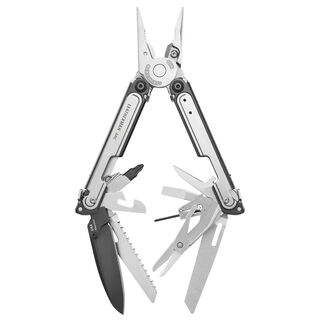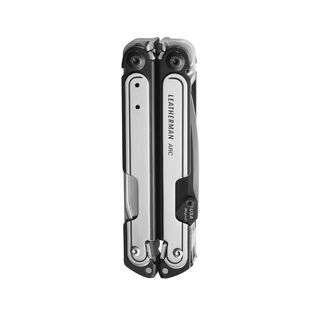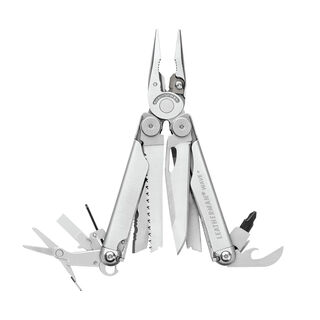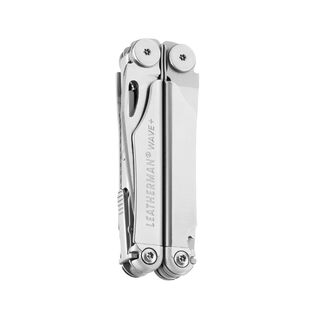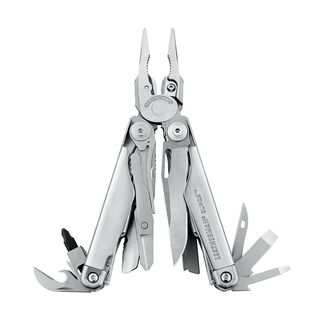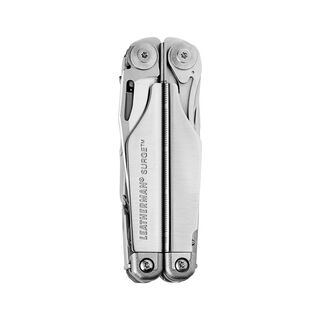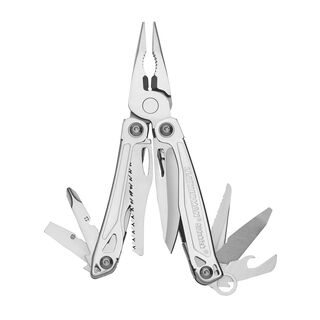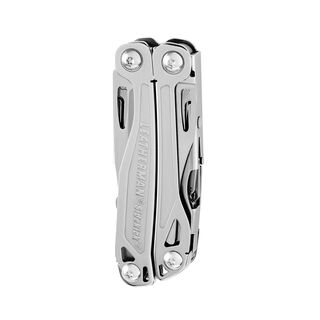ENTER THE TORTURE CHAMBER:
INSIDE THE LEATHERMAN TESTING LAB
INSIDE THE LEATHERMAN TESTING LAB
Before any Leatherman multi-tool design is put into production, it must run a gauntlet of stress tests. Some engineers call the room housing these machines the Testing Lab. Tim Leatherman himself has dubbed it something more colorful: the Torture Chamber.
In the Torture Chamber, prototypes are twisted, poked, punched, prodded, bent, squeezed, and hammered. The goal? To simulate real-world conditions and see how new tools and their implements will hold up to the abuse.
To learn more about the Torture Chamber, the role it plays in product development, and where some of these specialized testing devices come from, we spoke with Peter Parker, Leatherman’s Product Design Engineering Lead. Here’s what he told us.

Hi, Peter. Thanks for taking the time to talk to us today. Can you introduce yourself and tell us a little bit about what you do here at Leatherman?
My title is “Lead Design Engineer”, which is just a normal Design Engineer that knows where all the bodies are buried...[laughs] Seriously though, at Leatherman the DE’s role is the protection of the user experience and product performance. That might come during design phase of NPD (New Product Development) or continuous improvement of existing products. For new products, we design products around user needs and create engineering specifications to measure performance.

This is a Blade Grinder (not a pry bar!)
This is a Blade Grinder (not a pry bar!)

It was interesting to see the date stamp (1996) on the File edge retention Machine. It looks like the Testing Lab can trace its origins back to the company's early days. Can you share what you know about its history and what role it plays today?
Leatherman has performance tested products since the beginning of the company. Although the tools are beautiful pocket “bling” and fun to fiddle with, that’s not the point of the tool. The saw needs to cut wood, the knife should hold an edge, and the pliers should cut baling wire. The lab is how we assess and measure those functions, by applying technical engineering requirements of the user experience.
If we recreated the 1996 era File Tester now, it would look a little different due to modern automation but would still be simulating the user’s experience of the material removal. Our customers aren’t filing off digital media in 2023; it’s still metal and wood (and maybe a torn fingernail).
It seems like testing in the lab falls into one of two broad buckets: testing the body of the tool for durability and then testing the individual implements for functionality. Is that a fair assessment?
Sure, but we realize the user isn’t going to separate body durability from implement function. If the handle snaps off, then the screwdriver isn’t going to be as useful… But yes, we can separate some of the functions into a unique part which is independent of the architecture that holds it. A Leatherman saw should cut a wood dowel at the same rate whether it’s installed in a 4.5” Surge® or a more modest Sidekick®.
Talk to us about some of the testing devices and how they are engineered and/or sourced. Is "the Octopus" or the Strap Cutter something you can buy off the shelf or are we designing and building them from scratch?
The lab contains a range of test equipment, some that we purchase complete and others that are custom to Leatherman. Knife processing is measured via “edge retention” on an industry standard CATRA device. We also have the Universal Test Machine that is an instrumented platform that pushes and pulls whatever we put in its path.
The Octopus is our nickname for a set of linear slides that we perform all our cycle testing. Some of the UTM and Octopus fixturing is beautifully thought out and others are, well, more zip-tie and bubble gum MacGyvered than calibrated science. New features and functions require following hunches down quick and dirty test routes.


The ARC’s MagnaCut blade tested for edge retention on the CATRA machine slicing through layers of special textured paper
The ARC’s MagnaCut blade tested for edge retention on the CATRA machine slicing through layers of special textured paper.
With a multi-tool like ARc that's been under development for years, how early is the Testing Lab involved?
The Design Engineering team begins using the lab when the next product is just a sketch on a napkin. Prototypes’ test results tell us if we are headed in the right direction before we waste a lot of resources on a dead-end design.
Let's say a new prototype is brought to you for testing. Is there a checklist you follow or is the process more ad hoc and does it vary according to the needs of that particular tool? In other words, walk us through the process of how a tool gets tested.
This question is assuming a scenario that’s a little off. Each engineer is responsible for their own design, prototypes, and to determine whatever testing is required. We do have a lab technician (Anthony) who may physically perform the test. Often the engineer and Lab Tech will work together to create and qualify a new test. Test requirements are often common between different products (i.e., handle grip strength, can opening, prying, nail cutting, etc.) and those tests can be modified and repeated.

So, you've gotten test results. What happens next?
The lab is a way to measure the performance of a given function. Initially on a new function, there is a lot of feedback required from the user demographic to determine what they value and what performance meets their needs. Later, once that’s been established, we use test results to measure the design and the manufacturing processes of the product. These later tests are either an audit of quality or perhaps troubleshooting or improving a production process.
Can you think of an instance where testing helped the product evolve or deliver new benefits that maybe were unexpected?
During the initial design of the FREE series pliers (P2, P4), we needed a mechanism that could provide the handle deploy detent with high force over a short distance. Steel features make lousy springs for this, so we started working with urethane cylinders tucked into the plier's ear. Testing showed they solved the handle detent torque and positive sounding “click” open, but also cycle testing on the Octopus lasted forever. I’d share test results with you, but we literally could not get a failure after a million cycles. Stress corrosion cracking also kills steel springs, but not urethane, so it’s almost pointless to test rubber in a salt fog environment (we did anyway).


The “Octopus” testing the resilience of the Bit Driver Extenders
The “Octopus” testing the resilience of the Bit Driver Extenders.
Do you have a favorite torture device?
The most used implement on my daily carry ARC is the Pry Bar. Yes, the design isn’t anything fancy; it’s just a thick screwdriver. But lab testing has shown this tool can take normal user “abuse”. This implement eliminates the cringe and shame of bending or snapping-off another random implement. This makes me happy (and maybe our Warranty dept. too?).
thanks, peter!
A huge thank you to Peter for taking the time to talk to us and inviting us into the lab.

This pair of pliers is about to endure the “Grip Twist” to test for how much torque can be applied. Eye protection recommended.
This pair of pliers is about to endure the “Grip Twist” to test for how much torque can be applied. Eye protection recommended.
we asked around
We asked some notable folks at the office for their thoughts on the Torture Chamber:

Our CEO, Ben Rivera’s gives us some history:
“LEATHERMAN did not build a lab. It was accumulated over decades of MPT creation. We have received countless tool tales and warranty returns. The vast majority of returns are not defects in material or workmanship, but rather wear or failure from creative use that none could have imagined ahead of time. We welcome them all (and fix them) because we learn from them. We have developed tests for our tools based on what we expect consumers to do with our tools and to simulate the ways they have failed performing unexpected tasks to save the day.”
“My favorite tests? Jaw strength testing machine…because so many of our tool tales are about how the jaws were creatively used to grip, cut, bend, pry. We have learned from those stories and improved our products.
I also like the simple force gages that can be adapted to many functions to measure push and pull force like blade opening torque and lock release pressure.”

Director of Product Development, Melissa Covel’s thoughts on the lab:
“In our testing lab, we subject our products to a battery of trials and evaluations. The process is a mix of anticipation and analysis, where we hope for success but also recognize the value in failures. From generating scientific stress-strain curves to cycle testing our products for thousands of cycles, our lab covers an array of evaluations.
I enjoy watching the tensile/compression tester load, deform, and break our various implements, handles, and jaws. It's incredible to observe how our products break as we iterate through design and material variables, each time seeking improvements to the product.
These tests are critical for refinement, helping us to design products that exceed the expectations of our consumers.”

Founder, Tim Leatherman’s Favorite Torture Device:
“I love to watch the ingeniously designed cycle tester open and close the pliers jaws tens of thousands of times at hundreds of times per hour. Two of my other favorites are the seat belt cutting test and the machine that tests knife blades for sharpness and edge holding.”
ready to read more?
Interested in more insights from Leatherman’s engineers? Watch Leatherman CEO Ben Rivera talk about the History of the Wave, and learn how this bestselling multi-tool came to life. Or take a peek inside our factory when Essential Craftsman stopped by for a tour.
